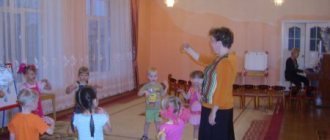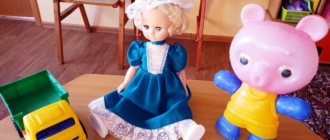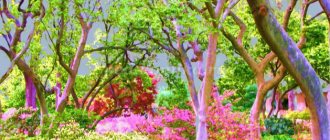Summary of the educational lesson “My City”
My city
Cognitive lesson in the middle group
Tasks.
Continue to consolidate children’s knowledge about the name of their hometown and introduce it to its sights. Bring to the understanding that the people who built the city tried very hard and did their job well. Develop a sense of pride in your city
Material
. Slides with photographs of your hometown (at the teacher’s choice); photographs (city, village, several landscapes, park, square); an envelope with a cut-out picture “Assemble a new attraction for the park” (for each child).
Preliminary work.
Compiling the album “My City”, reading poems and stories about my hometown. A trip with parents to your favorite vacation spots in your hometown (square, children's park, beach, embankment, Sports Palace, museum, circus, etc.).
Progress of the lesson
The lesson begins with reading a poem about your hometown. Educator: “Guys, what do you think this poem is about? (About the city, about its beauties, about nature.)
What is our city famous for? Who lives in it? Do we live in a city, in a town or in a village?” (Children’s answers.)
Invite the children to look at the illustrations (a city, a village, several landscapes, a park, a square), and put aside those that depict the city. Children complete the task.
Educator: How did you guess that this was a city? (The city has many tall buildings, large streets; there is transport, a lot of people, a lot of shops.)
Right.
A place where many people live, where there are many streets and buildings, is called a city. There are a lot of cities, they are all different. Each city has its own name. For example, the main city of the Motherland is Moscow. If we live in a city, then who are we? (City residents, townspeople, Muscovites, Miass residents, etc.)
What are the people who live in the village called?
(Villages, village residents, etc.)
You have probably already visited many places beloved by city dwellers with your parents.
Tell us where you visited with your parents and what interesting things you saw in our hometown. (Children's stories.) What good words can you say about our city? (Beautiful, big, clean, ancient, young, cheerful, green, famous, etc.)
The teacher invites the children to go on a tour of their favorite city without leaving the group. He asks: “What can you use to travel around the city?” (By bus, car, trolleybus.)
At the request of the children, the type of transport they will “travel” is chosen.
The teacher invites the children to take seats in the transport. Children sit on chairs arranged in a row of two, slightly diagonally, for a better view of the photographs that the teacher will demonstrate.
Educator: We hit the road and drive through the streets of our city. (On the slide is a photograph of the main street.) What do you “see from the window? (Pay attention to the photo: there is a road on it, cars, buses are driving, a store is visible, a lot of people, etc.) What street is this? (Wide, large, paved.)
Or maybe some of you know the name of this street? (If the children don’t know, name the street.) We arrived at the first stop, a favorite place for the townspeople - a children’s park. (There is a photo of the park on the slide.) Do you like to visit a children's park? What's in this park? (Children's answers). The teacher invites the children to add new attractions to the children's park. To do this, you need to collect cut-out pictures (distribute envelopes with cut-out pictures to the children).
The game “Assemble a new attraction” is played.
When the children complete the task, the teacher asks each child: “What new attraction have you built? Where will it be located in the park? Offers to continue the journey through his hometown. (On the slide is the next photo, “Cinema”.)
Educator: What are they doing at the cinema? How many of you have been to the cinema? What films and cartoons did you watch? What is there in the cinema halls? How should you behave at the cinema? (Children's answers)
The tour of our hometown continues. Similarly, consider photographs of other objects.
Ask the children a few questions about each object and offer a game task: “Tell me what you know about this place”, “Find a familiar place in the city”, “What’s extra?” etc.
In conclusion, the teacher says: “Our beautiful city was created and built by people of different professions. They tried, they worked well, to make the city comfortable to live in, to make it very beautiful and big. If every resident does something good for the city, it will become even more beautiful.”
Literature used: “Acquaintance with the subject and social environment” by O.V. Dybina
Photos were selected on the Internet
GCD in the senior group “Our Hometown”
GCD in the senior group “Our Hometown”.
Target:
nurturing in children an interest in the history of their city, a sense of love and pride for the city in which we live.
Tasks:
Educational:
Organize and consolidate children’s knowledge about their hometown and its attractions.
introduce children to the concept of “Small Motherland”.
Educational:
To form in children feelings of love for their city.
Educational:
To develop children's cognitive interest and cognitive abilities;
develop vocabulary.
Equipment and materials:
a laptop for demonstrating a presentation of the city's attractions, album sheets for drawing, pencils, musical accompaniment - a song about the city.
Preliminary work:
Conversations about your hometown, city attractions;
reading literary works about the Motherland;
watching cartoons from the series “Mountain of Gems”, “Legends of the City”
Progress of the lesson.
Children go out onto the carpet and form a circle.
Guys, please show me your palms. Now rub them together. What do you feel? (warm). That's right - warm. This is the warmth of your kind hands. Take each other's hand and give warmth to your friends.
The children take their seats.
1.What is the name of our kindergarten? Children: “Sunny.” 2. What city do we live in? Children: city of Alapaevsk 3. Our country is called... Children: Russia 5. What streets of our city do you know? Children name the streets where they live. 6. On what street is our kindergarten located? Children: Pushkin.
Today we will go on a virtual tour of our city. Ready? (demonstration of a presentation of a city attraction).
Game "Guess what is pictured." Children try to remember from the slides what kind of buildings in our city are depicted. Maybe the children visited some attractions with their parents and they are familiar with them. Children's stories from personal experience.
Physical education minute
Early in the morning we get up, (raise your hands up and lower them to the sides) We see the city outside the window. (point with your hands at the window) He woke up, he lives, (hands on the belt, springs in both directions) Calls us to the street. (walking in place ) Houses are different: High and low, (raise your arms up and lower them) Distant and close, (extend your arms and bring them closer to you) Wooden, panel, brick, (move with one hand as if counting) Seemingly ordinary. (spread hands) We live, we grow in our native city. (gradually rise on your toes with your arms raised and take the position.) For some it’s small, (show a small object with your hands) But for us it’s huge. (raise your hands up and lower them to the sides) Let it grow, Let it bloom (hands on the belt, springs in both directions) Our modest town (spread straight arms to the sides).
And now I suggest you play the game “What? Where? When?".
Guess, guys, there are riddles about the city. I’ll start reading poetry, you’ll have to continue. Trains are noisy everywhere, and people are going everywhere. From all sides, from all ends, Who are waiting for the trains to arrive. We invite him to the hall, What is called... ( station
) 2. Here you can leave a letter, Send a telegram.
Call your mom on the phone while on a business trip. You can buy an envelope here Send a parcel urgently. Say hello to everyone. After all, this building is... ( mail
) 3. People in white don’t get bored, They don’t sit idle, They prescribe a course of treatment. These people in white.
If someone gets sick, everyone goes for treatment to the city, regional, children's... ( hospital
) 4. What kind of wonderful house is this?
There are a hundred children in that house, The house is very happy for the children. What is this... ( kindergarten
) 5. If the refrigerator is empty, If there is nothing to eat, There is no bread, no cabbage, There is no butter and buckwheat.
You come here quickly And take a basket, Buy what’s tastier In our... ( store
)
Game "You can - you can't."
Children stand in a circle. - Children, let's talk about what you can do at home, on the streets of the city and what you can’t do. I will ask a question, and you will answer silently using a sign. Clap is correct, hands down is not. • Cross the street when the light is red. • Pick flowers in the flowerbed. • Admire the blooming flowerbed. • Plant trees and flowers. • Throw in candy wrappers. • Cross the road when the traffic light is green. • Screaming, making noise in public places. • Speak in a calm, polite tone.
I invite you to depict our city and organize an exhibition of drawings “My Favorite City”.
Well done boys!!! And now our virtual journey has come to an end. Please tell me what you remember and liked most?! Remember the name of the street in our city where you live?!



